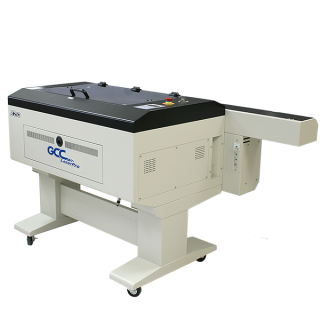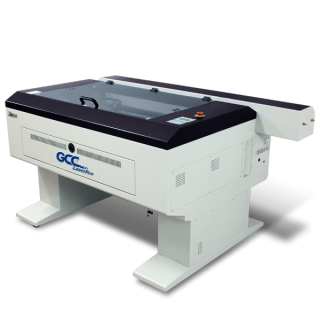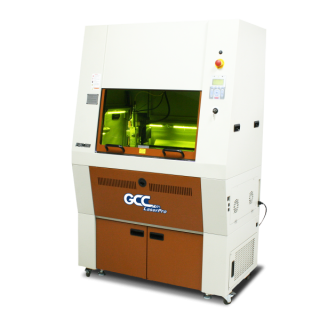Laser Cutting Precision, Versatility, and Applications

Laser cutting is a process that’s widely used for an array of applications. This versatile technology utilizes a concentrated beam of light that cuts through or engraves materials quickly and precisely.
Many industries use laser cutting. These include sheet metal fabrication, fashion and textiles, jewelry making, prototyping and rapid manufacturing, architectural models, PCB manufacturing, and electronics, to name just a few.
Utilizing laser cutting in these industries brings a multitude of benefits. Laser cutting plays a pivotal role in improving the finished quality of products, promoting automated processes, reducing resource consumption, and boosting productivity. As laser technology advances, the applications for this in-demand technology are set to grow even further.
How Laser Cutting Works
Before we start exploring the subject of laser cutting in more detail, let’s first pause to explain how laser cutting and laser cutting processes actually work.
Laser cutting utilizes a laser beam to cut or engrave materials. This process involves the output of a high-power laser being directed through optics. The laser beam is first directed onto the material’s surface. The intense heat from the laser beam then melts, burns, or vaporizes the material along the cutting path. This results in an accurate edge with a high-quality surface finish.
Types of Lasers
There are two types of lasers most commonly used in GCC LaserPro laser cutting, these include:
CO2 Lasers
CO2 lasers are powered by a combination of electricity and a gas mixture that contains CO2. These lasers operate at a wavelength of 10.6 micrometers, and are typically used on non-metallic materials.
Uses of CO2 lasers:
- Cutting
- Engraving
- Marking
- Drilling
- Usually used on wood, acrylic, plastics, foam, paper, and textiles.
Fiber Lasers
Fiber lasers use optical fibers doped with rare earth elements such as erbium and neodymium to generate a laser beam. Fiber lasers operate at a wavelength of 1.064 micrometers. These high-power lasers are known for their ability to cut through thicker materials.
Uses of fiber lasers:
- Cutting
- Engraving
- Marking
- Drilling
- Usually used on metals such as stainless steel, brass, and aluminum.
Laser Cutting Components
Now that we’ve described what a laser cutter is and the two main types of lasers used in GCC LaserPro laser cutting, it’s time to take a closer look at the workings of the laser cutter.
First, let’s examine the components used in a laser cutting system. A laser cutting system consists of the following main components:
Focusing Optics
The laser cutter’s mirrors and lenses are its focusing optics. The mirrors and lenses ensure accurate laser cutting by directing the laser beam to the precise focal point that needs to be cut or engraved.
Motion Control System
A Closed-loop DC servo motor can deliver greater continuous shaft power at higher speeds than a stepper of the same frame size. In addition, It can also give far greater accuracy due to closed-loop position feedback and the continuous movement, instead of constant stopping and starting.
Material Handling Mechanisms
The material handling mechanisms of the laser cutter include its rotary chuck and film clamping device. These components position and move the material to ensure optimum stability and position during the laser cutting process.
Each of the above components has a crucial role to play in the highly intricate and precise process of laser cutting.
The components work together as follows to cut materials precisely:
- First, the laser beam is produced by stimulating the lasing material within a closed container. The mirrors or fiber optics then direct the laser beam at the workpiece.
- Next, the beam makes contact with the material and heats it to either melt, vaporize, or burn (depending on the requirements of the job).
- High-pressure gas blows away the excess material to ensure a perfectly clean finish.

Advantages of Laser Cutting
Laser cutting is a widely used technique. Laser cutting technology continually evolves at a rapid pace bringing with it exciting developments that benefit the end-user. Here are its main advantages:
Precision and Accuracy
One main advantage of laser cutting is its exceptional precision and accuracy. The focused laser beam ensures that there is minimal deviation, allowing intricate cuts to be made with perfect accuracy. This ensures that a laser cut finish is superior to other cutting techniques.
Versatility
Laser cutting is a highly versatile technique that’s employed across many different industries and is suitable for a wide range of applications. This is because laser technology can be used to cut a wide range of materials. Wood, metals, fabric, plastics, and many more materials can be cut with exceptional accuracy using laser technology.
Efficiency and Speed
As well as delivering precise cuts on a wide range of materials, laser cutting also helps to cut down on production time. The laser cutting process is incredibly fast, which results in rapid processing. The laser performs each cut by moving swiftly across the material, meaning that production time can be significantly reduced when compared to traditional cutting methods.
Minimal Material Wastage
Reducing material wastage is something that all businesses aim to achieve. After all, less waste means more profit and improved efficiency. The precise nature of laser cutting means material wastage is significantly reduced. This is achieved by the remarkable accuracy of laser cut technology, which eliminates the errors that can be made when using traditional cutting techniques. The narrow kerf width also ensures that far less material is lost during the cutting process. This cuts down on material wastage, making the laser cutting process a cost-effective and environmentally friendly technique.
Common Uses of Laser Cutting
Laser cutting is widely used across many industries. Due to its many advantages, including superior precision and efficiency, laser cutting is a highly versatile technology. Common uses for laser cutting are as follows:
Manufacturing and Industrial Applications
Laser cutting is a technique commonly used in sheet metal fabrication for industrial parts. The superior degree of accuracy provided by laser cutting also means that it is used in the automotive and aerospace industries where precision components are manufactured to strict tolerances.
Electronics
Laser cutting performs an essential role in PCB manufacturing where precision is required to ensure optimal device performance. In addition, laser cutting is used in the electronic industry for cutting and engraving the tiny components found in devices such as smartphones, tablets, and medical instruments.
Signage and Advertising
Laser cutting techniques are also used in the creation of custom signs used for advertising. Custom signs created using wood, metal, and acrylic can all be made using laser cutting techniques to ensure a high-quality finish. Laser cutting is also employed in the construction of intricate components used in exhibition displays at trade shows. The level of accuracy provided by laser cutting ensures that the exhibition displays are of the highest standard and showcase the business in the best way.
Fashion and Textiles
Laser cutting is most associated with wood and metal. However, these aren’t the only materials that can be laser cut. The fashion and textile industries also use laser cutting techniques extensively. Laser cutting is used to cut fabrics to precise measurements, and to create intricate designs used on accessories, footwear, and clothing. Personalized fashion items, such as monogrammed belts and bags also utilize laser techniques.
Art and Design
Laser cutting can be used for creative purposes, such as in the art and design industry. Some artists use laser techniques to create intricate wall art, decorative objects, and even sculptures. Jewelry makers can also use laser cutting to create highly detailed pieces made from materials such as wood, metal, and acrylic.
Architecture and Construction
For the architecture and construction industry, laser cutting is an essential technique used to create scale models to precise measurements. At the other end of the construction process, laser cutting is used by interior designers to create custom features. This includes interior design elements such as screens, wall panels, and decorative shutters.
Education and Prototyping
Laser cutting is often used in academic settings in design, engineering, and architecture study programs, to provide hands-on experience to students. Laser cutting is also used in the rapid prototyping process used for product development and testing before mass production begins.
Factors to Consider in Laser Cutting
As we’ve demonstrated, laser cutting is a highly versatile and precise technique with a wide range of uses. However, it is essential to keep the following factors in mind to get optimal results from the laser cutting process:
Material Compatibility
Different materials can react in different ways when exposed to a laser. Therefore, choosing the right material is vital for successful laser cutting.
The following considerations should be kept in mind when choosing a material:
- Absorption
- Toxicity of the fumes produced by material when being laser cut.
- Reflectivity
Ideal materials for laser cutting include:
- Wood
- Metal
- Textiles
- Acrylic
- Plastics
Material Thickness and Complexity
The thickness of the material will impact the accuracy of the laser cutting and the speed at which it’s performed. Thicker materials will require more power and be cut at slower speeds. Thinner materials can be cut faster but require more control.
The complexity of the designs that will be cut will also impact the accuracy of the cutting. To allow for this, extra time may be required to set up and make adjustments during the cutting process.
Machine Settings and Maintenance
Achieving quality laser cuts requires careful adjustment of the machine’s power and speed settings, ensuring that the focus is correctly positioned, and using gas assist to blow away any molten materials.
Ensuring proper cleaning and maintenance is also vital. This involves cleaning the cutting bed, lenses, aligning optics, and mirrors regularly. The machine should also be regularly inspected for signs of wear. Consumables and cooling systems should be monitored and replaced when needed.
Laser Cut Machines Recommendations
Which of our GCC laser cut machines is right for you? Compare our different models below to help you find the perfect match for your needs:
X252 Laser Cutter
The GCC LaserPro X252 offers an economical alternative for laser cutting and engraving. It is equipped with a dependable sealed CO2 laser, providing a reliable source of 80W and 100W power suitable for mass production requirements.
Specifications:
- Working Area: 635 x 458 mm (25 x 18 in.)
- Z-axis: 165 mm (6.5 in.)
- Wattage: 80W~100W
- Speed: 40 IPS
Reasons to Buy:
- Economical equipment, suitable for beginners.
- Closed-loop DC servo control for precise and rapid movement of the lens carriage.
- Pass-through doors to accommodate oversized objects.
X380 Laser Cutter
The GCC LaserPro X380 is equipped with a dependable sealed CO2 laser, providing a reliable source of laser power for mass production. It features numerous innovative and user-friendly characteristics, giving users an edge over others.
Specifications:
- Working Area: 960 x 610 mm (38 x 24 in.)
- Z-axis: 165 mm (6.5 in.)
- Wattage: 80W~100W
- Speed: 40 IPS
Reasons to Buy:
- Reliable DC CO2 glass laser tube makes it an economical choice.
- Closed-loop DC servo control for precise and rapid movement of the lens carriage.
- Pass-through doors to accommodate oversized objects.
FMC 280 Laser Cutter
The GCC LaserPro FMC 280 is a compact, high-power fiber laser cutting and engraving system. It delivers easy operation and produces spectacular cutting edges. Engineered for performance, it is ideal for achieving excellent output quality.
Specifications:
- Working Area: 712 x 370 mm (28 x 14.5 in.)
- Z-axis: 120 mm (4.7 in.)
- Wattage: 1.5kW peak power
- Speed: 20 IPS
Reasons to Buy:
- State-of-the-art fiber laser technology cuts up to 3mm thick stainless steel.
- Achieves 256 level grayscale, vivid image engraving.
- Compact and robust design saves workshop space.
- Multiple optional items such as Rotary Chuck to meet various needs.



